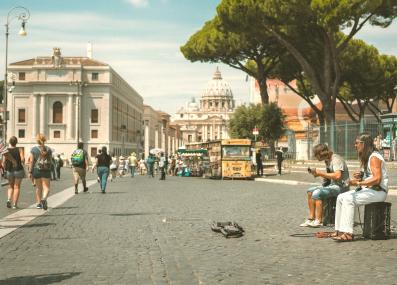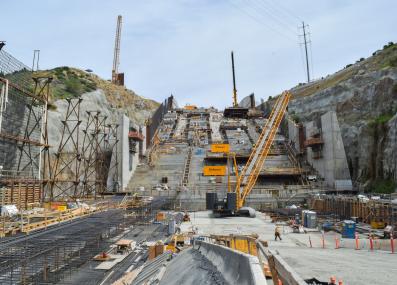Have a question?
Has all the pavement built by humans warmed the planet?
It’s possible, but if paving has had any effect on world temperatures, it’s far outweighed by our greenhouse gas emissions. In our daily lives, however, pavement can really heat us up—or, if we choose smarter materials, help cool us down.
June 10, 2025
Say it’s a hot summer day, and you’re outside with bare feet. If you can walk on black asphalt or a bright green lawn, which do you choose? “I would pick a grass surface every day of the week and twice on Sunday,” says Adam Schlosser, senior research scientist and deputy director of the MIT Center for Sustainability Science and Strategy. In other words, we know—perhaps through sole-scorching experience—that pavement can get hot.
Zoom out to the level of a city, with its dense network of roads, sidewalks, and parking lots, and pavement can really heat us up. Removing trees, grasses, and ponds means we lose out on their ability to move water into the air (or “evapotranspiration”), an important cooling feature of natural environments. Plus, dark pavement has what scientists call a low “albedo.” While high-albedo surfaces (think bright snow) reflect much of the sun’s energy, low-albedo surfaces, like dark roads or slate rooftops, absorb it. These built surfaces also have a knack for hanging onto that “extra” energy during the day, and as they release it overnight, they warm their surroundings.
These effects help explain why cities regularly run hotter, sometimes by several degrees Fahrenheit, than the surrounding countryside.1
So what if we zoom out even farther? Has all the pavement humans have built throughout history warmed our planet? It’s plausible, says Schlosser. But whatever the impact has been so far, it’s small: far outweighed by all the heat-trapping greenhouse gases humans have put into the atmosphere.
(By the way: Global warming is usually measured by “global mean surface air temperature.” Some processes, like increasing greenhouse gases or changing albedo, raise this temperature by keeping more energy in the Earth system; this is what drives climate change. Others, like changing evapotranspiration, don’t alter that total amount of energy—but we’re talking about them here, because they can still make it hotter near the ground where we live.)
Relative to the Earth’s whole surface, Schlosser says, “the amount of the planet that we’ve covered in roads and pavement is very small.” While it’s hard to say for sure how much of the planet is “urbanized”—partly because there’s no single definition of “urban” land—a recent study found that estimates ranged from about 0.5% of the Earth’s land area to around 2%.2 Those numbers shrink further when you consider that 70% of Earth’s surface is ocean. And they shrink even more when you consider that not all urban land is pavement.
Over long time periods, Schlosser says, we don’t have fine-grained data on how each acre of this pavement actually changed temperatures, especially for areas built up before the age of satellites. And if we want to estimate from changes like albedo, the details matter: Replacing a white sandy beach with a dark road has very different impacts than cutting down a dark forest and adding light concrete. Paving also tends to come with other changes, like the addition of buildings or parks, which have their own effects on albedo. (In fact, many cities have a higher albedo than the areas around them—though they still generally suffer from increased heat because of other factors, like the loss of plant life.3, 4)
Despite the complexity, scientists have tried to measure how global temperatures are affected by changes to urban land. (Depending on the study, that might include not only the outward sprawl of pavement and buildings, but also changes within city limits.) As recently as 2021, the Intergovernmental Panel on Climate Change concluded that urbanization has a “negligible” effect on global temperature.5
Some more recent studies have used satellite data to find slight warming effects, on a global level, from urbanization in recent decades.4, 6 These studies differ in their measures of temperature, their definitions of “urbanization,” and more, but none find large effects on a planetary scale. Globally speaking, urban land use adds at most a tiny boost to the heating for which our greenhouse gas emissions are overwhelmingly responsible.
On the other hand, says Hessam AzariJafari, deputy director of the MIT Concrete Sustainability Hub, you miss an important part of the story if you don’t also consider how built surfaces can put more greenhouse gases in the air. For example, if pavement raises city temperatures, that can change how much people heat and cool their homes—and if energy use rises, so do greenhouse gas emissions. Or what about the greenhouse gases released when a forest is cut down and paved over? AzariJafari argues that, when you add in effects like these, pavement becomes a bigger player in global warming.
Besides, urban heating—from pavement and other city features—can impact people’s lives without greatly raising global temperatures, especially in built-up areas like eastern China and the eastern United States.4 Schlosser says he doesn’t think in global terms when it comes to pavement: “It’s the local effect that we need to be worried about.” City dwellers are particularly exposed to health risks from extreme heat, and that exposure is on track to get worse as climate change intensifies heatwaves and more people move to urban areas.5
Cities can also take steps to bring relief from that heat—including by rethinking their pavement. “There’s an opportunity to use these human-made surface areas and turn them into a solution,” says AzariJafari.
AzariJafari studies “cool pavements,” engineered to warm their surroundings less than dark-colored materials. His research has found that strategic use of reflective pavements could lower peak summer temperatures in a hot city like Phoenix by more than 3 degrees Fahrenheit.7 Plus, AzariJafari says there are also benefits for the climate. After accounting for both the reflected sunlight and the indirect effects on greenhouse gases, his team found that brighter pavements could put a meaningful dent in Phoenix’s contribution to climate change. Other researchers, he adds, have studied the effect of brightening pavements and rooftops over a large portion of the world, and concluded this could lead to a slight global cooling.8
That doesn’t mean cool pavements can solve climate change on their own. But AzariJafari points out that little new effort is needed for cities to make these changes: Roads have to be maintained and replaced anyway, so there are regular opportunities to pick cooler paving materials. And crucially, he says, the few degrees of local cooling could really make a difference when a heatwave strikes.
Thank you to Nathan Matherly of Alexandria, Virginia, and to Les Powers for related questions.
Submit your own question to Ask MIT Climate
Get the latest from Ask MIT Climate monthly in your inbox
1 United States Environmental Protection Agency. "What are heat islands?" (Updated April 3, 2025). Accessed May 2025.
2 Chakraborty, TC, et al. "Large disagreements in estimates of urban land across scales and their implications." Nature Communications 15 (2024). https://doi.org/10.1038/s41467-024-52241-5.
3 Manoli, Gabriele, et al. "Magnitude of urban heat islands largely explained by climate and population." Nature 573 (2019). https://doi.org/10.1038/s41586-019-1512-9.
4 Zhou, Decheng, et al. "Urbanization contributes little to global warming but substantially intensifies local and regional land surface warming." Earth's Future 10 (2022). https://doi.org/10.1029/2021EF002401.
5 Doblas-Reyes, Francisco J., et al. "Linking global to regional climate change." (2021). In Masson-Delmotte, Valérie, et al (Eds.), Climate Change 2021: The Physical Science Basis. Contribution of Working Group I to the Sixth Assessment Report of the Intergovernmental Panel on Climate Change (pp. 1363-1512). Cambridge University Press. https://doi.org/10.1017/9781009157896.012. Specifically, this is in reference to global annual mean surface air temperature, which is what scientists use to track global warming. Note that the studies mentioned in the next paragraph do not all use the same measure of temperature.
6 Chakraborty, TC, and Qian, Yun. "Urbanization exacerbates continental- to regional-scale warming." One Earth 7 (2024). https://doi.org/10.1016/j.oneear.2024.05.005; Ouyang, Zutao, et al. "Albedo changes caused by future urbanization contribute to global warming." Nature Communications 13 (2022). https://doi.org/10.1038/s41467-022-31558-z.
7 AzariJafari, Hessam, et al. "Urban-scale evaluation of cool pavement impacts on the urban heat island effect and climate change." Environmental Science & Technology 55 (2021). https://doi.org/10.1021/acs.est.1c00664.
8 Akbari, Hashem, et al. "The long-term effect of increasing the albedo of urban areas." Environmental Research Letters 7 (2012). https://doi.org/10.1088/1748-9326/7/2/024004. Note, however, that not all studies have found reductions in global mean temperature from large-scale projects like these. See, e.g., the following study, which modeled widespread adoption of cool roofs and found a negligible impact on global mean air temperature: Zhang, Jiachen et al. "Revisiting the climate impacts of cool roofs around the globe using an Earth system model." Environmental Research Letters 11 (2016). https://doi.org/10.1088/1748-9326/11/8/084014.










